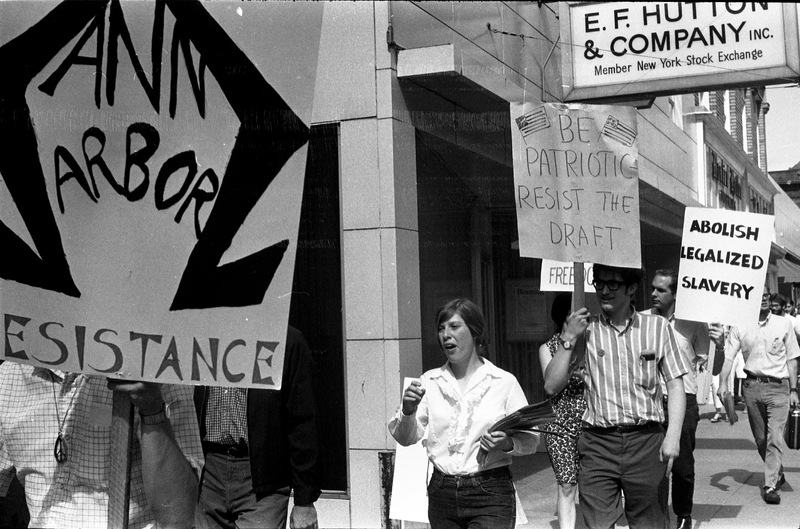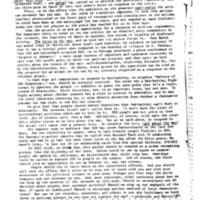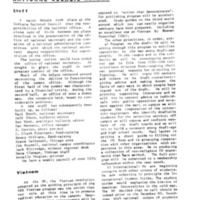SDS Changes Focus
Following the teach-in and March on Washington, the anti-war movement against Vietnam become more resistant. The faculty of universities, who started with the desire to inform their students, colleagues, and eventually America of the political and economic reasons for American intervention in Vietnam, became bystanders in the movement. Starting with the SDS-led March on Washington, students actively expressed their disagreement on American foreign policy.
In 1965, SDS gained tremendous momentum in its anti-war movement as its fame grew due to larger and more publicized protest events. In the wake of the March on Washington and the National Teach-in, SDS faced more redbaiting and press than ever before. However, SDS knew that defending itself against such accusations would only cause a distraction from its goals. Instead, as shown in SDS’s 1965 Special Edition Bulletin, SDS decided to keep its attention on the war and the draft, and to use the new publicity as “the greatest opportunity the anti-war movement has yet had.” When Paul Booth, who was one of the main organizers of the March on Washington in April 1965, was confronted in Washington D.C. about draft card burnings, he responded that “it was a trivial point when compared to the burning of villages in South Vietnam.” When LBJ criticized SDS, the organization responded by calling a press conference, but instead of responding to LBJ’s statements, it spent the next hour discussing the issues of the war: “self-determination, right-wing dictator Ky, lies from the administration, etc.” Even though SDS felt great temptations to respond to the redbaiting accusations and to take a stance for civil liberties, it resisted and continued to use its new-found fame to project its stance against the Vietnam War and the draft.
SDS used its growing fame effectively on college campuses and in communities in order to educate people about the draft. A SDS National Council Report from the summer of 1965 shows that the organization established a new program on campuses that aimed to “mobilize opposition to war among draft-age people.” The activists encouraged people to file the conscientious objector form so that they did not have to fight. SDS members were also trained to be “draft counselors.” They gave advice and educated people about the many ways that people avoided the draft. On campuses, SDS members worked to expose the “cooperation of the university registrars who identify draftable students for the selective service.” Off campus, the SDS members worked to “expose and confront members of the draft boards” and to try to “build a movement among draft-age and high school youth.”
SDS began to further broaden its relations at this time to strengthen its cause, as further exhibited in the SDS National Council Report from 1965.. It contacted unions of students internationally to build a movement of students during the Cold War and to “endorse the principle of International Student Strike.” Furthermore, SDS began forming more relations domestically to oppose the Vietnam War. It formed a new partnership with the National Coordinating Committee to End the War in Vietnam. SDS began urging students to “coordinate the October 15-16 action through it,” which would eventually become the International Days of Protest.
Although SDS did not always formulate its ideas into specific actions, it is evident from its newsletters that a real push towards taking action against the war and the draft was transpiring in 1965. From a referendum by SDS members to begin protesting the draft more specifically, it is evident that SDS began seeing the need to protest at universities “where there exists considerable defense research” and “where the registrars is cooperating with the draft by sending in names of students in the lowest 4th of their class.” SDS had already recognized that research ties between the university and the Cold War were taking place at “Berkeley, Stanford, and Wayne State.” Furthermore, SDS began suggesting that when military recruiters appear on campus, “they should be the focus of attention, challenged to debate, accused by picket signs of participation in war crimes.” SDS argued that the same treatment should be given to ROTC officials on campus. The new direction that SDS began to take to recognize the problems of the draft and their universities’ relations to the war set the foundations for the more action-based forms of protesting that SDS soon adopted in order to protest the draft, their universities, and the Vietnam War, as a whole.
Citations for this page (individual document citations are at the full document links)
"SDS National Council Report on Vietnam," 1965 SDS Bulletin Volume 4 Special Edition, Links to Resources from Students for a Democratic Society and Related Groups and Activities. http://archive.lib.msu.edu/AFS/dmc/radicalism/public/all/sdsbulletin/ALZ-5.pdf
"Special Edition Bulletin Introduction," 1965 SDS Bulletin Volume 4 Special Edition, Links to Resources from Students for a Democratic Society and Related Groups and Activities. http://archive.lib.msu.edu/AFS/dmc/radicalism/public/all/sdsbulletin/ALZ-5.pdf
"SDS Draft Referendum," 1965 SDS Bulletin Volume 4 Special Edition, Links to Resources from Students for a Democratic Society and Related Groups and Activities. http://archive.lib.msu.edu/AFS/dmc/radicalism/public/all/sdsbulletin/ALZ-5.pdf





